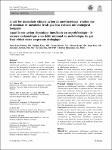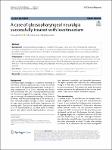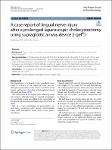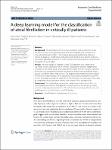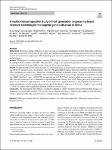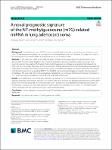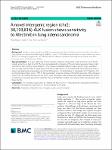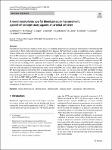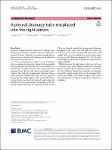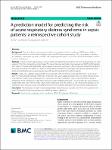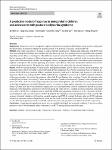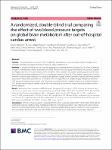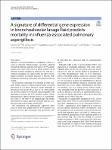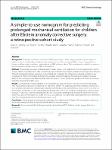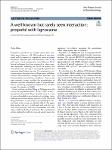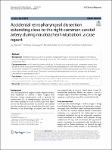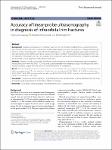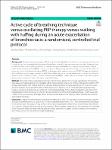Author
- Daqing, Ma (3)
- Alexis, Ferré (2)
- Anna, Lybeck (2)
- Ashish K., Khanna (2)
- next >
Subject
- intensive care unit (8)
- acute respiratory distress syndrome (5)
- chronic obstructive pulmonary dis... (5)
- ICU (5)
- next >
Date issued
Has File(s)
OER- Y học- Điều dưỡng (384)
Bộ sưu tập tài liệu chuyên ngành: kỹ học y học, nghiên cứu, ứng dụng y học...
Item Title - Ascending [/1]
Climate change is a global threat, and inhalational anesthetics contribute to global warming by altering the photophysical properties of the atmosphere. On a global perspective, there is a fundamental need to reduce perioperative morbidity and mortality and to provide safe anesthesia. Thus, inhalational anesthetics will remain a significant source of emissions in the foreseeable future. It is, therefore, necessary to develop and implement strategies to minimize the consumption of inhalational anesthetics to reduce the ecological footprint of inhalational anesthesia. |
Glossopharyngeal neuralgia is a condition that causes severe pain in the throat during swallowing. Although carbamazepine is a viable option for treating glossopharyngeal neuralgia, there are minimal data regarding the effect of alternative agents to treat it. We report on glossopharyngeal neuralgia, which is successfully controlled by levetiracetam. |
The lingual nerve is a branch of the mandibular nerve which is a branch of the trigeminal nerve and provides general sensation to the anterior two-thirds of the tongue, and this nerve lies deep to the hyoglossus muscle (Dotiwala and Samra 2018). |
Atrial fibrillation (AF) is the most common cardiac arrhythmia in the intensive care unit and is associated with increased morbidity and mortality. New-onset atrial fibrillation (NOAF) is often initially paroxysmal and fleeting, making it difficult to diagnose, and therefore difficult to understand the true burden of disease. Automated algorithms to detect AF in the ICU have been advocated as a means to better quantify its true burden. |
Newborn screening (NBS) is an important and successful public health program that helps improve the long-term clinical outcomes of newborns by providing early diagnosis and treatment of certain inborn diseases. The development of next-generation sequencing (NGS) technology provides new opportunities to expand current newborn screening methodologies. |
Lung adenocarcinoma (LUAD) is characterized by high morbidity and mortality rates and poor prognosis. N7-methylguanosine play an increasingly vital role in lung adenocarcinoma. However, the prognostic value of N7-methylguanosine related-miRNAs in lung adenocarcinoma remains unclear. |
Anaplastic lymphoma kinase (ALK) rearrangement, which is mostly showed as fused with echinoderm microtubule-associated protein-like 4 gene (EML4), accounts 3–7% of all common mutations in non-small lung cancer (NSCLC). An intergenic region (chr2: 30,193,816), which located on upstream of the adjacent ALK gene, was never been reported as a ALK patterner before. |
Accurately evaluating the lymph node status preoperatively is critical in determining the appropriate treatment plan for non-small-cell lung cancer (NSCLC) patients. This study aimed to construct a novel nomogram to predict the probability of lymph node metastasis in clinical T1 stage patients based on non-invasive and easily accessible indicators. |
Smartphones may provide a highly available access to simplified hypertension screening in environments with limited health care resources. Most studies involving smartphone blood pressure (BP) apps have focused on validation in static conditions without taking into account intraindividual BP variations. We report here the first experimental evidence of smartphone-derived BP estimation compared to an arterial catheter in a highly dynamic context such as induction of general anesthesia. We tested a smartphone app (OptiBP) on 121 patients requiring general anesthesia and invasive BP monitoring. |
A 70-year-old female presented to our department due to requiring for extracting a pleural tube penetrated into the right heart 22 days ago. She was previously hospitalized for the right femur fracture. The patient had rheumatic heart disease with mitral and tricuspid valves replaced. She suffered deoxygenation following internal femur fixation. |
The risk of death in sepsis patients with acute respiratory distress syndrome (ARDS) was as high as 20–50%. Few studies focused on the risk identification of ARDS among sepsis patients. This study aimed to develop and validate a nomogram to predict the ARDS risk in sepsis patients based on the Medical Information Mart for Intensive Care IV database. |
The present work was designed to explore whether electrocardiogram (ECG) index-based models could predict the effectiveness of metoprolol therapy in pediatric patients with postural tachycardia syndrome (POTS). |
This study aimed to assess the effect of different blood pressure levels on global cerebral metabolism in comatose patients resuscitated from out-of-hospital cardiac arrest (OHCA). |
Influenza-associated pulmonary aspergillosis (IAPA) is a severe co-infection with the fungus Aspergillus, affecting critically ill influenza patients. Mortality of IAPA patients reaches 45%, more than twice as much as observed in influenza patients admitted to intensive care unit (ICU) without aspergillosis [1]. Importantly, the effect of antifungal treatment on patient outcome is limited, while prognostic biomarkers tailored for this patient group are lacking. |
Prolonged mechanical ventilation (PMV) after pediatric cardiac surgery imposes a great burden on patients in terms of morbidity, mortality as well as financial costs. Ebstein anomaly (EA) is a rare congenital heart disease, and few studies have been conducted about PMV in this condition. This study aimed to establish a simple-to-use nomogram to predict the risk of PMV for EA children. |
Propofol is considered an excellent intravenous anesthetic agent. However, a 30–70% incidence of pain associated with its injection is a significant source of patient discontent. Injection pain and discomfort rank as the sixth most crucial perioperative issue (Desousa 2016). Several techniques have been employed to reduce injection discomfort, including the use of the forearm and antecubital veins, freezing or warming the injectate, and aspirating blood before injection. Pre-treatment or contemporaneous administration of thiopentone, pethidine, fentanyl, dexamethasone, nitroglycerine, ketorolac, and local anesthetics has also been considered. |
Retropharyngeal dissection is a possible complication during nasotracheal intubation. We report a case of a retropharyngeal dissection extending close to the right common carotid artery occurring while inserting a nasotracheal tube. |
Maxillofacial fractures are a common cause of visits to emergency department, accounting for more than 400,000 annual visits in the United States. Gold standard diagnostic tool is conventional computerized tomography (CT) or 3DCT reconstruction. However, the disadvantages of CT are radiation exposure, unavailable in some hospital and expensiveness. Whereas the bony structures overlap is a problem in diagnostic when using plain film X-ray. The objective of this study is to show the accuracy of a linear-probe ultrasound compared to computed tomography and plain film X-ray in diagnosis of infraorbital rim fracture. |
Airway clearance techniques (ACTs) for individuals with bronchiectasis are routinely prescribed in clinical practice and recommended by international guidelines, especially during an acute exacerbation. However, there is limited evidence of the efficacy of these techniques during an exacerbation to improve sputum expectoration, health-related quality-of-life (HRQOL) or exercise tolerance. The primary aim of this study is to compare the effects of the active cycle of breathing technique (ACBT), oscillating positive expiratory pressure (O-PEP) therapy, and walking with huffing on sputum expectoration for adults hospitalised with an acute exacerbation of bronchiectasis. |
To compare the severity of pulmonary embolism (PE) and the long-term complications between patients with and without COVID-19, and to investigate whether the tools for risk stratification of death are valid in this population. |

